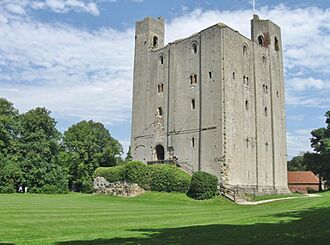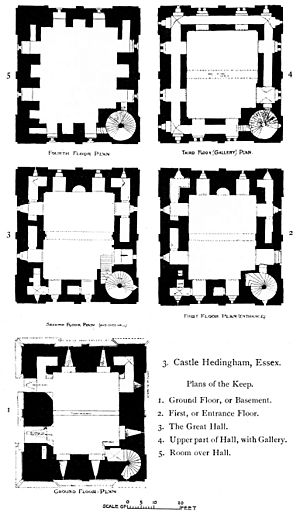Hedingham Castle facts for kids
Quick facts for kids Hedingham Castle |
|
|---|---|

Hedingham Castle, 2012
|
|
| General information | |
| Type | Castle |
| Architectural style | Romanesque |
| Address | Castle Hedingham, Essex, United Kingdom |
| Coordinates | 51°59′33″N 0°36′04″E / 51.99250°N 0.60111°E |
| Owner | The Lindsay family |
Hedingham Castle is a famous old castle in the village of Castle Hedingham, Essex, England. It has one of the best-preserved Norman keeps in the country. A "keep" is the main tower of a castle. The castle's defenses and other buildings were first built around the year 1100. The tall keep was added later, around 1140.
Today, the keep is the only large medieval part of the castle that still stands. It is a very important historical site. You can visit the keep and explore this amazing piece of history.
Contents
Exploring Hedingham Castle
The land where Hedingham Castle stands was given to a Norman baron named Aubrey de Vere I by William the Conqueror around 1086. The de Vere family built the castle in the late 1000s and early 1100s. The main tower, or keep, was built between the 1130s and 1140s.
To make space for the castle, a big ditch was dug. This ditch cut through a natural hill, creating a strong defensive area. This area included an inner part called a "ringwork" and an "inner bailey." A "bailey" is an enclosed courtyard. There was also an "outer bailey" that stretched further into the valley.
The Castle Keep
The stone keep is the only medieval building that has survived. It is in excellent condition, almost like new. The keep is nearly square in shape, which was common for Norman keeps. The east and west sides are about 16 meters long. The north and south sides are about 17.5 meters long.
The main part of the keep stands over 21 meters tall. Its turrets, which are small towers on top, rise even higher. They are about 4.5 to 7.5 meters above the walls. From its high position, the keep overlooks the countryside. The walls are very thick, about 3.3 meters at the bottom. They are made of flint stones held together with mortar. The outside of the walls is covered with smooth stone blocks called "ashlar." These stones were brought all the way from a quarry in Barnack, Northamptonshire.
The keep has five floors inside. One of the most important rooms is the Great Hall, also called the Banqueting Hall. It has a large fireplace and a big arch that goes up two floors. Some experts believe the top floor might have been added around the 1400s. This floor might have replaced a pyramid-shaped roof.
Changes Over Time
Over the years, the castle changed. During the Tudor period, which was in the 1500s, some changes were made. Two of the original four corner turrets are now missing. They were likely removed to get stone for other building projects by King Henry VII.
Other buildings outside the keep, like the old hall and drawbridge, were replaced during the Tudor period. However, these new structures have also been lost over time. The only exception is a red-brick bridge with four arches. This bridge connects the inner and outer parts of the castle. It was built in the late 1400s or early 1500s and has been repaired many times. A small chapel used to be located near the stone keep.
Around the year 1700, a new red-brick mansion was built. This mansion was in the Queen Anne style. Sir William Ashhurst, a Member of Parliament and former Lord Mayor of London, built it. He bought the property in 1693, and the mansion was finished before he passed away in 1719.
A Look at History
Hedingham Castle might have been built on the site of an even older castle. This earlier castle was likely built by Aubrey de Vere I in the late 1000s or early 1100s. Hedingham was one of the biggest pieces of land Aubrey I owned. Records from the Domesday Book show he owned Hedingham by 1086. He even ordered vineyards to be planted there. The castle became the main home for the de Vere family.
Aubrey de Vere II and Aubrey III are thought to have started building the big stone tower. This was probably to show the family's growing importance. In 1133, Aubrey II became the "master chamberlain" of England. In 1141, his son Aubrey was given the title of Earl of Oxford.
Matilda, who was the wife of King Stephen, passed away at Hedingham Castle on May 3, 1152. The castle was attacked twice, in 1216 and 1217. These attacks happened during a fight between King John, some rebel barons, and a French prince. Both times, the sieges were short, and the attackers quickly took the castle.
The de Vere family owned the castle for a very long time. There was a short break during the Wars of the Roses. The castle was taken from the de Veres in 1462. This happened after John de Vere, 12th Earl of Oxford, was executed for going against King Edward IV. Edward then gave Hedingham to his brother, Richard, Duke of Gloucester. Richard later became King Richard III.
After Richard III died in 1485, the new king, Henry VII, gave Hedingham back to the de Vere family. This was to John de Vere, 13th Earl of Oxford, who had supported Henry VII.
In 1713, William Ashhurst bought the castle. After he passed away in 1720, the estate went to his great-great-granddaughter, Margaret Elizabeth Lindsay. She was married to Lewis Majendie. The Majendie family owned Hedingham Castle for 250 years. Then, Musette Majendie left it to her cousin, The Honourable Thomas Lindsay. He was related to the de Veres on both his mother's and father's sides. Today, his son Jason Lindsay and his wife Demetra live at Hedingham Castle with their children.
Hedingham Castle Today
Hedingham Castle is still a family home. However, the Norman keep and the castle grounds are open to visitors from Easter until October. Schools also visit the castle throughout the year for educational trips.
The castle grounds are a popular place for many events. These include jousting tournaments, archery displays, and falconry shows. You can also see historical re-enactment battles, fairs, and shows for classic and vintage cars. Music concerts and theatre plays are also held there. The castle and its buildings are often used for special ceremonies and parties.
Hedingham Castle is known as "the best preserved Norman keep in England."
Filming and Photography
Hedingham Castle has been used as a location for many films and TV shows.
- In 2010, it was featured in episode 2 of The Landscape of Man on Channel 4. This episode showed how the castle grounds and gardens were restored after being left wild for many years.
- The castle was a filming location for the movie The Reckoning (2004).
- It was also used for the BBC series Ivanhoe (1997).
- In 2001, the British pop group Steps filmed part of their music video for "Words Are Not Enough" inside the castle.
- Documentaries like Made in Britain (2005) with Fred Dibnah, The Shakespeare Theory (2013) with Derek Jacobi, and A History of Britain with Simon Schama have all used Hedingham Castle.
- In 1997, the castle was the setting for a photo-shoot for Vanity Fair magazine. This shoot featured fashion designer Alexander McQueen and Isabella Blow. The photograph can be seen in the National Portrait Gallery, London.
- The castle is also the location for John Cleese's The Dinosaur Hour on GB News.


